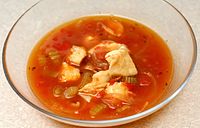Ostry
Free State of Ostry
| |
|---|---|
| Anthem: Tu na nordacë Here in the north | |
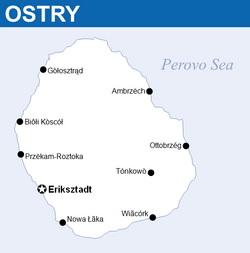 | |
| Country | |
| Status | Free state within a federal monarchy |
| Annexation into Werania | TBD |
| Devolution | 1 January 1986 |
| Capital | Eriksztadt |
| Government | |
| • Type | Devolved parliamentary republic in a federal monarchy |
| • Body | Dorada |
| • Minister-Chairman | Johann Schöttmer |
| Area | |
| • Total | 210 km2 (80 sq mi) |
| Population (2010) | |
| • Total | 21,630 |
| • Density | 100/km2 (300/sq mi) |
| Demonym | Ostric |
| GDP (PPP) | |
| • Total | $600 million |
| • Per capita | $27,739 |
| GDP (nominal) | |
| • Total | $490 million |
| • Per capita | $22,940 |
| Official languages | Ostric Weranic |
The Free State of Ostry (Ostric: Wòlné Państwò Òstrsczi; Weranic: Freistaat Ostrei) is an island and constituent state within the Lands of the Weranic Crown. Located within the north Boreal Sea, Ostry has a population of 21,630, the smallest of any subdivision in Werania. Its capital and largest city is Eriksztadt, located on the leeward side of the island.
History
Geography
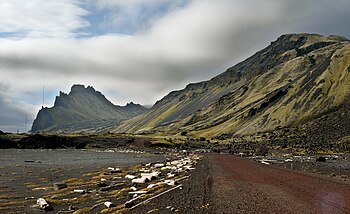
Ostry is located in the northern portion of the Perovo Sea, where it connects to the larger Boreal Sea. The island, 210 square kilometres in size, is dominated by hills and mountains, which occupy the central portion of the island. Its highest peak, Biôła Góra, rests at 497 m (1631 ft) above sea level, and is considered a dormant volcano. Due to Ostry's hilly terrain, as well as its arctic climate, most of the island's population resides on the coast, primarily in the flatter southern portion. Ostry's closest neighbour is Ordennya, which maintains irregular ferry services to and from and island.
Climate
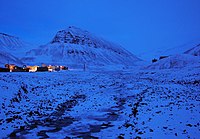
Ostry has a climate considered in between taiga and tundra, similar to other landmasses that straddle the north of Euclea. The island experiences very cold and long winters, normally from October to May, and colder, short summers. Ostry has few forested areas, mainly around the southern coast, and rarely gets large amount of sunshine due to the cloudy weather. During the height of the summer months, especially in July, Ostry experiences the midnight sun, or consistent 24-hour sunlight due to its latitude. This also comes with the opposing polar night during the winter months.
| Climate data for Ostry | |||||||||||||
|---|---|---|---|---|---|---|---|---|---|---|---|---|---|
| Month | Jan | Feb | Mar | Apr | May | Jun | Jul | Aug | Sep | Oct | Nov | Dec | Year |
| Average high °C (°F) | −1 (30) |
0 (32) |
2 (36) |
5 (41) |
8 (46) |
9 (48) |
13 (55) |
10 (50) |
9 (48) |
5 (41) |
2 (36) |
0 (32) |
5 (41) |
| Daily mean °C (°F) | −6 (21) |
−4.5 (23.9) |
−1.5 (29.3) |
1 (34) |
3.5 (38.3) |
6.5 (43.7) |
10.5 (50.9) |
8 (46) |
4 (39) |
1 (34) |
−2.5 (27.5) |
−4 (25) |
1.3 (34.4) |
| Average low °C (°F) | −11 (12) |
−9 (16) |
−5 (23) |
−3 (27) |
−1 (30) |
4 (39) |
8 (46) |
6 (43) |
−1 (30) |
−3 (27) |
−7 (19) |
−8 (18) |
−2 (28) |
| Average precipitation mm (inches) | 54 (2.1) |
49 (1.9) |
46 (1.8) |
41 (1.6) |
39 (1.5) |
35 (1.4) |
38 (1.5) |
55 (2.2) |
74 (2.9) |
80 (3.1) |
77 (3.0) |
62 (2.4) |
650 (25.4) |
| Source: Geological Association of Werania | |||||||||||||
Government
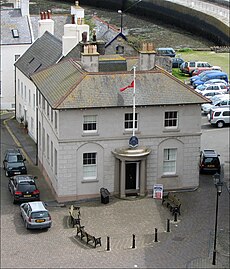
Ostry is a constituent free state of the Land of the Weranic Crown, with the right of self-governance in most domestic affairs, while maintaining a deep connection with the federal government. The Ostric regional government is headed by the Minister-Chairman, who is considered the head of government and main executive and legislative role on the island. They are elected by a vote of confidence by the members of the Dorada. As Minister-Chairman, they head the Cabinet of Ostry, made up of themselves and four other ministers.
The unicameral Dorada, elected every four years, is made up of fifteen members elected by proportional representation. The Assembly is in charge of maintaining the free state's budget, and proposing and voting in new laws. All Weranic citizens residing on the island over the age of 18 have the right to vote or run in Ostric elections. Due to the small population the Dorada represents, with a Member of the Dorada representing around 1,424 constituents on average, Ostric political culture is often considered highly based on personal relations and heavily influenced by local events and issues.
On the federal level, Ostry is represented by one seat in the Volkstag, being one of the least-represented regions in the Reichstag. Ostry's status as a free state and lack of representation has been a driving issue on the island, with a large portion of the population sympathetic to the idea of Ostry either getting further devolved powers or outright becoming independent from Werania, through various means.
Administrative divisions
Ostry is divided into nine municipalities (Ostric: gmina; Weranic: Gemeinde), consisting of the main settlement and, in the case of larger and more rural municipalities, smaller nearby hamlets and communities. The municipality is the only recognized administrative division on the island.
| Municipality | Population | Area km2 | Density (Area km2) |
|---|---|---|---|
| Eriksztadt | 6,235 | 13 | 480 |
| Przëkam-Roztoka | 3,400 | 26 | 130 |
| Tónkowò | 3,273 | 35 | 94 |
| Biôłi Kòscół | 2,793 | 22 | 130 |
| Wiãcórk | 1,527 | 18 | 85 |
| Gòłosztrąd | 1,494 | 24 | 62 |
| Ottobrzég | 1,130 | 17 | 66 |
| Ambrzëch | 1,103 | 24 | 46 |
| Nowa Łãka | 675 | 31 | 22 |
| Ostry | 21,630 | 210 | 100 |
Relationship with Werania
Military

As a constituent state of Werania, Ostry is under the direct protection of the Weranic Armed Forces. Continuing its historical role as a northern military post, the port of Eriksztadt often acts as a fueling station for Weranic naval forces. The regional government of Ostry has no control over the armed forces stationed on the island, excluding a small police force of around 300 and joint control of the Coast Guard.
Coast guard
Although de jure under the jurisdiction of the federal government, the Ostric branch of the Weranic Coast Guard is jointly operated by both the federal and regional government, and considered the most permanent military force on the island. The Coast Guard maintains a fleet of around 25 patrol boats, the largest being the Czerwińc. The organization patrols Ostric waters daily, often in order to stop illegal fishing and whaling, especially in times of depletion, and inspecting imports to the island via sea. The Coast Guard also has a relatively sophisticated search-and-rescue operation, often working in conjunction with federal Coast Guards.
Economy
Ostry has an economy primarily based on fishing and tourism, and devotes much of its economic infrastructure to these industries. As a constituent state of Werania, Ostry is de facto part of the Euclean Community, including its single market, allowing freedom of movement and trade. The island uses the euclo as its currency, and generally has a high standard of living, although is considered comparatively lower then in mainland Werania.
Fishing and agriculture
Since the island's habitation, Ostry's economy has been dependent and dominated by fishing and whaling. The industry still dominates today, with the majority of the island's population employed in the sector. Fishing, primarily cod fishing, accounts for over seventy-five percent of the island's exports, and is the sole employer of note in many rural municipalities. Due to the domination of the fishing industry, and the growing issue of climate change disrupting traditional areas of heavy schools of cod, the industry is prone to regular collapse, often leaving the island in recession and increased emigration.
Whaling has also historically been important to the Ostric economy, although it has been declining sharply since the 1980s, due to a combination of expansion into other industries, and stricter regulations on whaling due to the endangered status on arctic whales in the region.
Tourism
Tourism is the second-largest industry in Ostry, with the island seeing around 100,000 tourists per year, mainly within the months of May to September. Main points of interest include mainly the natural beauty of the island, as well as the town of Eriksztadt. Due to this, the town has developed a relatively sophisticated night life and culture despite its small size. The majority of tourists come from Werania proper, as well as elsewhere from Euclea, such as Ordennya.The main port of entry for tourists is Eriksztadt Airport, which handles the vast majority of visitors to the island. Recently, the Ostric government has begun to extensively promote eco-tourism and has heavily subsidized the local tourism industry, including discussion over designating Ostry's uninhabited areas as a nature park and reserve.
Population
Demographics
As of 2010, Ostry has a population of 21,630, with the vast majority living along the island's coast. The largest municipality, Eriksztadt, has a population of 6,235, 29% of Ostry's total population. Another 27,833 form a Ostric diaspora on mainland Werania, mainly in larger cities such as Bürchaft and Westbrücken. Since the 1970s, Ostry has suffered significant brain drain, with many higher-educated Ostrins leaving the island for better living standards and higher wages.
Language
Ostry recognizes the Ostric and Weranic languages as official languages, and promotes a bilingual status in government, trade, and business. In the 2010 census, 15,061 (69.6%) speak Ostric as a first language, followed by 6,032 (27.9%) speaking Weranic, and 537 (2.5%) speaking another language as their primary tongue.
Unique for the region, Ostric is a Slavic language brought by settlers and refugees during the 9th and 10th centuries, with heavy influence taken from Weranic and other Germanic languages and dialects over the centuries. Historically, Ostric was considered endangered as Weranic gained prominence as the language of official business and government. This however has begun to change as Ostric was formally introduced into the education system and local government. Over 80% of the island's population state they are bilingual in some capacity.
Religion
The majority of Ostrins follow the Solarian Catholic Church, with 17,344 (81.2%) people members of the institution. The remaining population either claim to be irreligious (3,738 or 17.5%) or members of other faiths (278 or 1.3%), primarily Kasperism. Sotirianity came to Ostry in the 12th century with Weranic raiders and settlers, and has been the dominant religious institution on the island since. Catholics in Ostry are organized under the Diocese of Eriksztadt (Ostric: Diecezjô Eriksztadtskô; Weranic: Diözese Eriksztadt), under the jurisdiction of the Bishop of Eriksztadt.
Education
Ostry's education system, as part of the Weranic Ministry of Education, is heavily based on the Weranic and other Euclean models. Public education is free, and offered through ten primary schools, four secondary schools, and one university. The Ostric public system typically runs in blocks of two semesters from September to December and January to April. Education is compulsory for children within the primary (6-13) and lower secondary (13-16) education systems, and the rate of attendance to higher education has been steadily increasing.
The University of Ostry is the only institution of tertiary education on the island, with a student population of around 500. The university is connected with the University of Bürchaft on mainland Werania. Despite heavy investment into the institution by both the public and regional government, the university has failed to mitigate the large amount of Ostrins who leave the island to pursue higher education on the mainland or elsewhere in Euclea, contributing to a noticeable brain drain among islanders with bachelor degrees or higher.
Transport

There is one major roadway encircling Ostry, the Ostric Roadway, often nicknamed the Amber Route (Ostric: Darga Bùrsztinowé; Weranic: Bernsteinroute). The roadway, built in 1982, connects all the major municipalities, and allows the entire island to be traversed in around four hours. There are plans to provide a public transit bus around the island, but this has yet to be implemented. From 1870 to 1957, a narrow single-gauge railway ran from Eriksztadt to Gòłosztrąd, before ending service due to low demand.
There is one public airport on the island, Eriksztadt Airport, which offers biweekly flights to the Weranic mainland via Bürchaft. There also exists a consistent ferry service from Eriksztadt to Ordennya that runs twice weekly. Entry into Ostry, either by sea or air, is controlled by the Weranic Border Guard. By law, all ships entering from international waters must dock at the port in Eriksztadt before unloading.
Culture
Music
Ostry has a rich musical tradition, particularly in regards to sea shanties, which remain popular and a source of national pride. The first collection of Ostric sea shanties emerged in 1818 with Ludwig König's Lieder und Balladen von der ostrischen Insel. Pop music, rock and roll, and punk are also popular on the island. Due to Ostry's historical role as a military port, military marches and hymns have left their mark on the island's musical traditions, greatly influencing Ostry's national anthem.
Sport
Association football is the largest sport in Ostry, with Eriksztadt FC being the premier football club on the island. Since 2018, one Ostrin, Nikódem Nesz, has played for the Werania national football team as centre forward. Outside of football, ice hockey and basketball are also popular, with Ostry being notable within Werania for a number of significant hockey players, such as Julius Kneib and Ignacy Jedënak.
Cuisine
Ostric cuisine is heavily influenced by its climate, with cod being a staple in most dishes. Due to this, most Ostric dishes use seafood in their recipes, along with such other ingredients such as wheat, potatoes, and vegetables. The most internationally recognized Ostric dish is commonly zupa dôrszô, a broth made with cod and various other ingredients. Fish and chips (rëba z fritkômi) are also popular on the island, with a multitude of chip shops in most communities. Outside of seafood, lamb is also consumed widely, although not as much as fish. Popular desserts include poppy seed bread (chléb z môkiém) and cziesznia, a cake with a cherry base. Ostrins are well-known for their high consumption of alcohol, primarily beer and rum. A strong local liquor, kòrnus, has gained some popularity in international markets, particularly in Werania. The largest brewer on Ostry, Renifer, has become a symbol of Ostric culture abroad.
Public holidays and festivals
| Date | Name | Explanation |
|---|---|---|
| 1 January | New Year's Day | Celebration of the new year. |
| Variable, during the March equinox | Dësablota | Festival commemorating the end of winter and the beginning of spring. |
| 1 May | Labour Day | Celebration of workers and labourers. |
| Variable, during the summer solstice | Midsummer | Festival designating the longest period of daylight during the year. |
| Variable, during the September equinox | Harvest Day | Festival commemorating the end of summer and the beginning of autumn. |
| 20 November | National Territory Day | Commemoration of the Gardrag Agreement and the creation of the National Territory of Ostry. |
| 18 December | Day of the Republic | Commemoration of the declaration of independence in 1919 during the Navish Revolution. |
| Variable, during the winter solstice | Yule | Festival designating the longest period of night during the year. |
| 31 December | New Year's Eve | Celebration of the end of the current year. |





